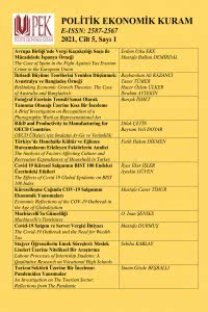Geçiş Ekonomilerinde Dış Yardımların Ekonomik Büyüme İle İlişkisinin Ampirik Analizi
Kavram itibariyle Doğu Bloku bir diğer bilinen karşılığı Sovyetler Birliği önderliğinde oluşturulan sosyalist blok, kısmen Asya ve Doğu Avrupa ülkeleri üzerinde yaklaşık 70 yıllık bir sürede hüküm sürmüştür. Birlik, ülkelerin siyasi, sosyal ve ekonomik yapılarını komünist özellikli ideolojik yapı çerçevesinde şekillendirmiştir. Karşı rakip Amerika Birleşik Devletleri benimsemiş olduğu piyasa ekonomisi ile merkezi planlamaya dayalı ekonomik sistemini sürdüren blok ülkeleri ile mücadelesini 1990 yılı birliğin çöküşüne dek sürdürmüştür. Üye ülkeler ideolojik yapının çözülmesiyle birlikte başta ekonomi olmak üzere çeşitli alanlarda reformlara başvurma gereği duymuştur. Söz konusu reformlara başvuran ülkeler geçiş ekonomisi terimi ile adlandırılmıştır. Bu çalışmada geçiş ekonomilerinde dış yardımlar ile ekonomik büyüme arasındaki nedensellik ilişkilerinin 2002-2018 dönemi için panel veri yöntemleriyle araştırılması amaçlanmıştır. Çalışma kapsamında yapılan yatay kesit bağımlılığı ve homojenlik testleri birimler arasında yatay kesit bağımlılığının olmadığını ve eğim katsayılarının homojen olduğunu göstermektedir. Bu nedenle çalışmada homojen panelleri dikkate alan nedensellik analizine başvurulmuştur. Analiz sonuçları ülkeden ülkeye farklılık göstermekle birlikte panelde yer alan ülkelerden Ermenistan, Çin ve Kazakistan için dış yardımlardan ekonomik büyümeye doğru, Azerbaycan için ise ekonomik büyümeden dış yardımlara doğru tek yönlü nedensellik ilişkilerinin olduğunu göstermektedir. Çalışmada dış yardımların yanı sıra bulguları çalışmanın uygulama kısmında paylaşılan enflasyon oranı, doğrudan yabancı yatırımlar, beşeri sermaye, ticarete açıklık ve kurumsal kaliteyi temsil eden değişkenler ile ekonomik büyüme arasındaki nedensellik ilişkileri de araştırılmıştır.
Empirical Analysis of the Relationship between Foreign Aid and Economic Growth in Transition Economies
In terms of the concept, the Eastern Bloc, another known counterpart, the socialist bloc formed under the leadership of the Soviet Union, ruled partially over the Asian and Eastern European countries for a period of 70 years. The Union has shaped the political, social and economic structures of the countries within the framework of the communist ideological structure. Its rival, the United States of America, continued its struggle with the bloc countries, which continued its economic system based on central planning and the market economy it had adopted, until the collapse of the union in 1990. With the dissolution of the ideological structure, the member countries felt the need to apply for reforms in various fields, especially in the economy. Countries applying for these reforms are named with the term transition economy. In this study, it is aimed to investigate the causality relations between foreign aid and economic growth in transition economies with panel data methods for the period 2002-2018. Cross-sectional dependence and homogeneity tests performed within the scope of the study show that there is no cross-sectional dependence between units and the slope coefficients are homogeneous. For this reason, causality analysis, which takes into account homogeneous panels, was used in the study. Although the results of the analysis differ from country to country, it shows that there are unidirectional causality relations from foreign aid to economic growth for Armenia, China and Kazakhstan, and from economic growth to foreign aid for Azerbaijan. In addition to foreign aid, the causality relations between the variables representing the inflation rate, foreign direct investments, human capital, openness to trade and institutional quality, and economic growth, whose findings were shared in the application part of the study, were also investigated.
___
- Adebayo, T. S. ve Kalmaz, D. B. (2020). Ongoing Debate Between Foreign Aid and Economic Growht in Nigeria: A Wavelet Analysis. Social Science Quarterly, 101(5), 2032-2051.
- Adedokun, A. J. (2017). Foreign Aid, Governance and Economic Growth in Sub-Saharan Africa: Does One Cap Fit All? African Development Review, 29(2), 184-196.
- Alemu, A. M., ve Lee, J. S. (2015). Foreign Aid on Economic Growth in Africa: A Comparison of Low and Middle-Income Countries. South African Journal of Economic And Management Sciences, 18(4), 449-462.
- Asteriou, D. (2009). Foreign aid and economic growth: New evidence from a panel data approach for five South Asian countries. Journal of Policy Modeling, 31(1), 155-161. doi: 10.1016
